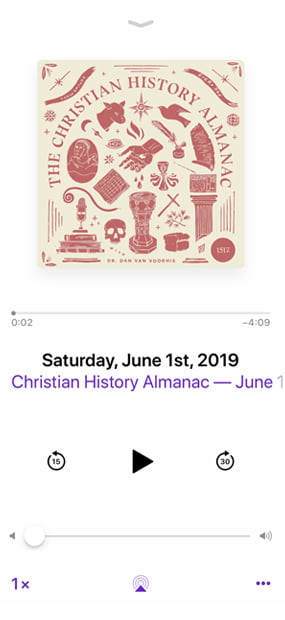Monday, October 20, 2025
Today on the Christian History Almanac, we head to the mailbag to answer a question about the divisions amongst Protestants.
It is the 20th of October 2025. Welcome to the Christian History Almanac, brought to you by 1517 at 1517.org; I’m Dan van Voorhis.
A very happy Monday to you- as usual, we head to the mailbag… a slew of questions have been coming in, perhaps because of a number of shows on the Reformation, I’ve received a number of questions on the different kinds of Protestants and the divisions between the groups.
A great conference this past weekend- shout out to everyone I met- and while I forget his name- the man with his son and sister from New Jersey who came up after my talk and asked me about Seth Rollins- my mind reeled for a second, which theological tradition is he… oh, no… the wrestler… that was awesome.
So- Nathan in Kingman, Arizona— I’ve been through there… It’s close to Oatman, which is the old mining town/ghost town today filled with burros… and Lisa from Murrieta, here in California- one time home of Calvary Chapel Bible College. I’ve been there, too…I believe I played mini-golf there when I was there for a faculty retreat, and my colleagues went to play poker at a dodgy casino. Nathan had a question about Luther and Calvin, and Lisa had a question about the “unaltered Augsburg Confession,” and we can wrap those two together.
First- the always necessary caveat: the Early Modern Church, even if it shares the name of your church’s denomination, isn’t necessarily the same. When I talk, broadly, about church traditions, I will always stress that for modern iterations of these traditions, you do well to go into these churches and learn about them from the current congregations and leadership…
Ok- so, the Reformation splinters over the doctrines surrounding the Lord’s Supper. This was the division between Luther and Zwingli in 1529. The Augsburg Confession was presented in 1530 by Melanchthon and the Lutherans- it was later altered by Melanchthon to try to bring the Lutherans and Calvinists together.
Let me start where I ended the Weekend Edition and my conference talk ended… the Protestant traditions are united in their Formal and Material principles. The formal principle is the primary authority: Scripture, and the material principle is Justification by grace alone, through faith alone, and by Christ alone.
So why did the doctrine of the Lord’s Supper divide them? For the Lutheran tradition, it is a core doctrine that Christ is truly present, in, with, and under the elements of Communion. Where Christ is present, he is present as his ‘whole’ self, human and divine. And to separate them is to go back on the central teachings of the Council of Nicaea. So, the Lutherans will not teach “transubstantiation” or “consubstantiation” but a “real presence”.
So- Philip Melanchthon is trying to facilitate union with other Protestants- he’s in correspondence with John Calvin- and Melanchthon will alter the wording of his confession. Interestingly, Luther, who would write the Schmalkaldic Articles, would also edit those after they were presented… but… well…
The original text of Article 10 in the Augsburg Confession reads: “Of the Supper of the Lord they teach that the Body and Blood of Christ are truly present, and are distributed”. The 1540 “Variata” reads: “they teach that, together with the bread and wine, the body and blood of Christ are truly exhibited to them that eat of the Lord's Supper”.
Truly present, or truly exhibited? It’s worth noting that Luther and those Lutherans in 1540 didn’t initially object to the changes but came to see it in the 1570s as an unwarranted change.
The union of Protestant churches has long been a prickly issue- it was the “Protestant Union of Churches” in Prussia in 1817 that led to the exodus of many Lutherans who would make their way to the New World, up the Mississippi into the Missouri territory to create, you guessed it, what we call today the “Missouri Synod”.
While an outlet like a podcast can explore theological differences, I should note that we belong to particular churches- and so these divisions matter, and we find ourselves living as the church in concrete places with specific confessions. I’m the historian pointing out the differences, and you need to decide where you sit.
But starting with the history and the doctrine is, hopefully, helpful. Thanks for the questions, Nathan and Lisa, and you can send me your questions at danv@1517.org.
The Last word for today comes from the daily lectionary and Psalm 57:
Have mercy on me, my God, have mercy on me,
for in you I take refuge.
I will take refuge in the shadow of your wings
until the disaster has passed.
I cry out to God Most High,
to God, who vindicates me.
He sends from heaven and saves me,
rebuking those who hotly pursue me—
God sends forth his love and his faithfulness.
This has been the Christian History Almanac for the 20th of October 2025, brought to you by 1517 at 1517.org.
The show is produced by the always Unaltered… A UAC man- he is Christopher Gillespie.
The show is written and read by a man who knows that a tortilla filled with beans supposedly looked like a “little burro,” hence the name: Burrito. I’m Dan van Voorhis.
You can catch us here every day- and remember that the rumors of grace, forgiveness, and the redemption of all things are true…. Everything is going to be ok.

Subscribe to the Christian History Almanac
Subscribe (it’s free!) in your favorite podcast app.